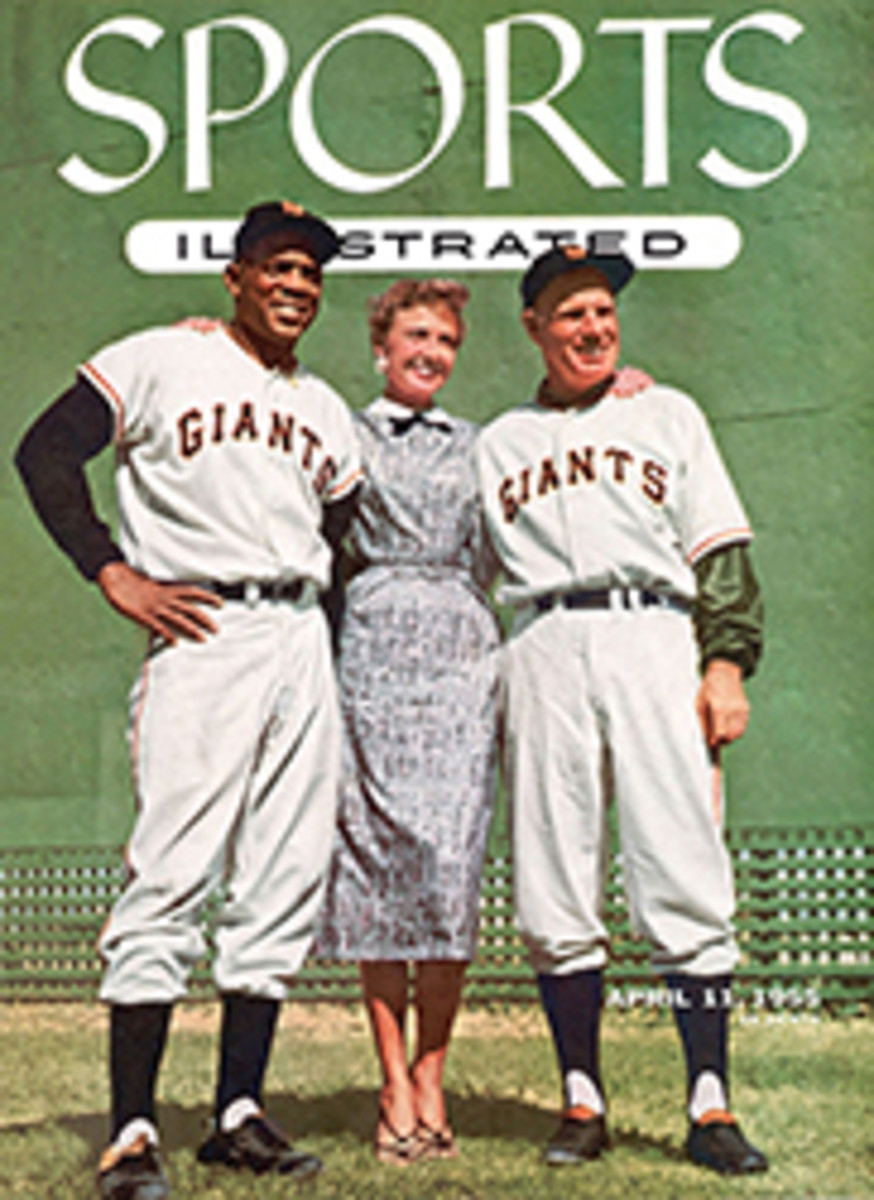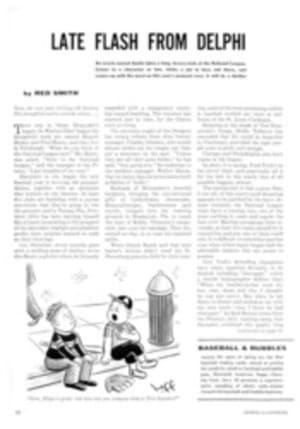
BRIGHT YEAR FOR U.S.
The 1955 skiing season wound to a climax at Stowe, Vt., March 18-20 when Europe's hottest racers took on the U.S. National champions and Olympic candidates. In the women's division, the Americans clearly proved that they have long since caught up with European competition, as Andy Lawrence, Katy Rodolph and Skeeter Werner finished 1, 2, 3.
But in the Stowe meet, Anderl Molterer (below) of Austria demonstrated just as clearly that the best male skier in the world was still a European. Molterer won the slalom, giant slalom and combined at Stowe, then moved out to Sun Valley to win the combined at the Harriman Cup.
However, no one had to feel too badly about losing to Molterer, who had already won the International Mont Blanc Ski Week in France, and the Austrian national championship, and was generally conceded to be the finest skier in amateur competition. Besides, there was plenty of consolation in the dozens of other races where the Molterers, not to mention the Lawrences, Werners, et al. did not compete. At the NCAA championships, for example, Middlebury's fine four-way skier Les Streeter took home the title of Skimeister. At the Junior championships in Whitefish, Mont., Penny Pitou of Gilford, N.H. won the downhill and slalom and later earned an alternate spot on the 1956 Olympic team.
NEWCOMERS ON THE JUMPS
There were some exciting newcomers among the jumpers, too. Rudy Maki, 19, of Ishpeming, Mich., won the national title with jumps of 270 and 259 feet, then broke the Olympic tryout record with a leap of 300 feet at Iron Mountain, Mich. Two other teen-agers, Ragnar Ulland, 17, and Dick Rahoi, 19, made the team at Iron Mountain. These three, together with veterans Art Devlin, Roy Sherwood and Bill Olson, make up the most promising team of jumpers the U.S. has entered in international competition.
It was an exciting winter, too, for the hundreds of thousands of non-racers who make up the backbone and flesh of the sport. The snow came early and deep, and it held through the winter. Half the resorts in America had continuous skiing from December right on through Easter vacation, and 75% of the areas lost only a few days.
In the East the infant Princeton Ski Bowl on Bearpen Mountain in New York reported 24 inches of snow at Thanksgiving. As early as mid-December, Alta, Utah, had three feet. Aspen, Donner Summit, Calif. and the Reno Snow Bowl had even more.
Right behind the snow came hordes of skiers, and they kept coming until last week the resort owners gleefully reported their most prosperous season. The most fortunate, perhaps, was Alec Cushing of Squaw Valley, who, besides catering to more than 100,000 skiers, won the nomination as U.S. candidate for the 1960 Olympic site.
Stowe, Vt. and North Conway, N.H. also reported more than 100,000 skiers, as did Mt. Hood, Ore. Bromley in Vermont counted 95,000. Snoqualmie, outside Seattle, got good snow and 94,000 skiers. Alta reported 84,000.
Not far behind the established resort owners, Walter Schoenknecht, free-spending head of the brand new Mt. Snow area in southern Vermont, scrambled like a big-city commuter to get on the gravy train. After shelling out nearly $1 million Schoenknecht counted 40,000 skiers for the year—close to a record for an opening season. And last week he stoutly maintained he would turn loose another $2,500,000 during the next four to seven years.
POLKA DOTS ON THE GLACIERS
If Europeans were as sensitive to statistics of this sort, they could document the same kind of season. After a rude setback in mid-January, when five days of rain swept the central Alps, the European resorts settled under a blanket of deep powder. So deep that glacier crevasses 50 feet deep were filled with snow and tours like the Eismeer Glacier near Wengen, and the run down from Testa Grigia above Champoluc—both normally experts' country—were safe for early intermediates.
European skiers were sporting a new look this season, a look that was beginning to be reflected in American ski fashions. Stripes, polka dots and gaudy colors began to creep from their plush nesting place at St. Moritz and spill over onto some of the world's most conservative ski slopes. In the Parsenn, for example, red ceased to be an honor color for fine skiers and became simply a pretty color for a pretty snow bunny to choose for her parka. Light blue, off-white and green splashed against the white slopes of the Alps, and occasionally of the Rockies and Sierras. And even the rockbound old mountains of New England sported a fair share of bright ski pants.
If the Europeans led in fashions, they followed in the matter of running equipment. Over the past four years, the plastic and metal Head Ski has become the single most sought-after ski in America. This year the European demand shot up, and the Head company shipped over 2,000 pairs with orders next season for 5,000.
Another big item was release bindings, worn this season by an average of 30% of American skiers. The percentage of release bindings was smaller in Europe, where there is a) more climbing and hence less interest in the tightly bound heel fixtures of many makes of release bindings, and b) less money to spend on fancy fixtures.
In ski schools, too, America seemed to be taking over the lead. At a dozen major areas, attendance at ski classes doubled and virtually all other resorts reported increases of 20-50%. There was no evidence of a corresponding rise in Europe, nor was there likely to be, since the mass of Europeans tend to regard the ski as a means for spending a day in the sun, whereas the American goes at it as though he were going to get the better of this sport or leave his bones on the mountain. As a result, the general level of skiing in the U.S. has now risen to a par with Europe.
While American skiing was marching briskly ahead, the country's skiing officials retrogressed at an even greater rate. The National Skiing Association occupied the greater part of the winter in a nasty little family squabble involving its Eastern and Western factions (SI, Feb. 21). And at the Olympic alpine trials at Stowe, the Olympic Ski Games Committee managed to confuse everyone with a bit of inexcusable ambiguity (see below). This sort of inept-ness was a bit disappointing to many Americans who have been hoping that, as the sport matured, skiing's hierarchy would mature along with it. The officials themselves insisted that the national situation would be cleared up at the NSA convention at Yellowstone in May.
In the meantime, there was more pleasant business at hand. With snow still lying deep after the heavy winter storms, many skiers have postponed their vacations till April. And this week they will take off for one of the most promising spring skiing seasons in memory. Cannon Mountain, Stowe and Mt. Washington report 20-60 inches of cover, while the high Western resorts like Alta have 60-120 inches—enough for six more weeks of skiing.
PHOTO
YEAR'S TOP SKIER, Anderl Molterer of Austria, mopped up European racing circuit before taking combined titles at both American International and Harriman Cup race.
TWO PHOTOS
Jill Kinmont, once Olympic hopeful but paralyzed from shoulders down after fracturing neck in race Jan. 30, smiles in railroad car in which she was moved last week from Salt Lake City hospital to St. John's in Santa Monica. Jill can move arms slightly, but fingers are still paralyzed. Helped by special Jill Kinmont Fund (SI Feb. 28), she faces drawn-out convalescence, long months of therapy. Nonetheless, Jill keeps spirits high, insists she'll regain championship form: "You can bet I'll be on the Olympic team in 1960."
OLYMPIC SNAFU
After two weekends of races in Vermont and New Hampshire, the 1956 Olympic alpine skiing team was chosen:
Men: Tom Corcoran, Brooks Dodge, Marvin Melville, Ralph Miller, Marvin Moriarty, Les Streeter, Dick Mitchell and Bud Werner.
Women: Andy Lawrence, Katy Rodolph, Dorothy Modenese, Betsy Snite, Skeeter Werner.
But there was some un-Olympic nonsense mixed up in the choosing.
The final Olympic trials held during Stowe's American International races were highlighted by two performances: Bud Werner's downhill run and skiing officialdom's spectacular sitzmark.
Halfway through the Stowe tryouts, the Olympic Ski Games Committee began to bicker with its picked group of technical experts. The experts felt that a previously issued bulletin defining selection methods gave them a loud voice in naming the team. The committee thought otherwise.
Getting together after the first race at Stowe (the fourth race in the tryouts), the committeemen announced that they meant, by the bulletin, that the team would be selected strictly on a point system. But the skiers had been urged by the experts to try for brilliant (and therefore risky) performances. As it stood, the top male skiers, including Bill Beck, U.S. downhill co-champion, came to Stowe with at least one fall or disqualification behind them. During the International the American men skied uncertainly and were roundly trounced by the Europeans.
Only the downhill was different. In it Bud Werner (SI March 14), all but eliminated by two earlier falls, hurled himself down the trail with one thing in mind—to win. He shaved the trees lining Stowe's Nose Dive trail in a chilling display of nerve and control. And when he came smoking across the finish line he had beaten the trail record by 9.2 seconds and the best European by 4.7.
And he made the Olympic team by two seconds. The other top skiers managed to race evenly into Olympic berths—all except Bill Beck (see cut), whose fall in the giant slalom cost him a spot on the regular team. The experts and racers themselves both protested Beck's exclusion, but to no avail. Brooks Dodge, an Olympic veteran who made the squad, summed it up: "I never looked forward less to being a member of a team. This sort of thing takes all the fun out of it."
MAJOR WINNERS OF 1955
UNITED STATES
VICTOR CONSTANT MEMORIAL: Martin Strolz, Austria
NORTH AMERICAN NORDIC COMBINED: Ted Farwell Jr., U.S. Air Force
SNOW CUP: men—Marvin Melville, Salt Lake City; women—Andrea Lawrence, Parshall, Col.NATIONAL JUMPING: Rudi Maki, Ishpeming, Mich.
GIBSON TROPHY: men—Chiharu Igaya, Dartmouth; women—Inger Jorgensen, NorwayNATIONAL CROSS COUNTRY: Tauno Pulkkinen, New York City
NATIONAL JUNIORS: boys' alpine combined—Martin Hale, Whitefish, Mont.; girls' combined—Penny Pitou, Gilford, N.H.; jumping—Roger Dion, Lebanon, N.H.; cross country—Phil Broomall, Rumford, Maine
NATIONAL INTERCOLLEGIATES: team—University of Denver; alpine combined—Chiharu Igaya, Dartmouth; jumping-Bill Olson, Denver; cross country—Larry Damon, Vermont; Skimeister—Les Streeter, Middlebury
ROCH CUP: men—Emery Woodall, Aspen, Col.; women—Babatte Hauissen, Squaw Valley, Calif.
NATIONAL ALPINE: men's combined—Chiharu Igaya, Dartmouth; women's combined—Andrea Lawrence, Parshall, Col.
AMERICAN INTERNATIONAL: men's three-way combined—Anderl Molterer, Austria; women's three-way combined—Andrea Lawrence, Parshall, Col.
HARRIMAN CUP: men—Anderl Molterer, Austria; women—Madeleine Berthod, Switzerland
NATIONAL GIANT SLALOM: men—Ralph Miller, U.S. Army; women—Jannette Burr Bray, Seattle
EUROPE
LAUBERHORN: Toni Sailer, Austria
SDS LADIES RACE: Madeleine Berthod, Switzerland
HAHNENKAMM: men's combined—Anderl Molterer, Austria; women's combined—Thea Hochleitner, Austria
INTERNATIONAL MONT BLANC WEEK: men's three-way combined—Anderl Molterer; women's triple combined—Putzi Frandl, Austria
MOSCOW INTERNATIONAL SKI WEEK: 15 kil. cross country—Vladimir Kusin, Russia; 30 kil. cross country—Martin Stokken, Norway; nordic combined—Per Gjelten, Norway; special jump—Sverre Stenersen, Norway
SWISS NATIONALS: men's three-way combined—Hans Forrer, Switzerland; women's triple combined—Ruth Fridlin, Switzerland
AUSTRIAN NATIONALS: men's alpine combined—Anderl Molterer, Austria; women's combined—Thea Hochleitner, Austria
CORTINA OLYMPIC REHEARSAL: alpine combined—Toni Sailer, Austria; 15 kil. cross country—Arvo Viitanen, Finland; 30 kil. cross country—Vladimir Kusin, Russia and Sixten Jernberg, Sweden (tie); special jump—Antti Hivarinen, Finland
FRENCH NATIONALS: men's alpine combined—Adrien Duvillard, France; women's combined—Suzanne Thiolliere, France
HOLMENKOLLEN WEEK: cross country—Aarne Hiiva, Finland; special jump—Aulis Kallakorpi, Finland; classic combined—Sverre Stenersen, Norway
ARLBERG KANDAHAR: men's alpine combined—Walter Schuster, Austria; women's combined—Hilda Hofherr, Austria
GORNERGRAT DERBY: men—Ernst Hinterseer, Austria; women—Luise Jaretz, Austria

